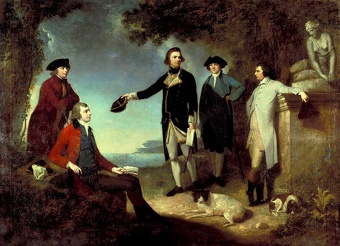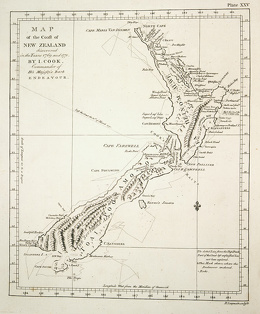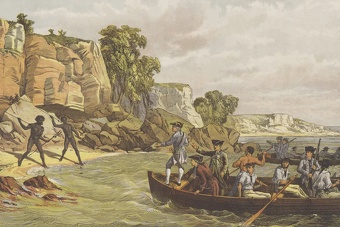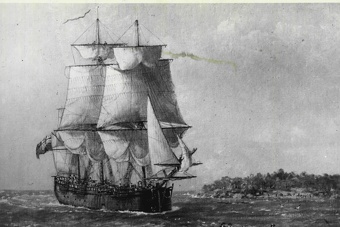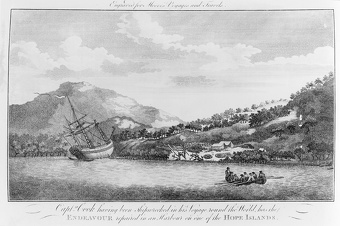Home | Category: History / History and Religion
COOK IN NEW ZEALAND AND AUSTRALIA
Captain James Cook was the first Europe navigators to extensively explore and survey Australia and New Zealand. His carefully drawn charts proved finally that New Guinea and Australia were not joined together, as many had supposed. He was the first to circumnavigate the two main islands of New Zealand. [Source:“Encyclopedia of World Cultures, Volume 2: Oceania,” edited by Terence E. Hays, 1991]
Cook visited Australia and New Zealand on his first voyage. Cook claimed both Australia and New Zealand for the English crown and set in motion a process that led their colonization by the British. He discovered that New Zealand was two islands not one. Australia had been visited before Cook by Dutch and British explorers but Cook established a tow hold there mapped much of it. Cook's expedition introduced the Maori of New Zealand and Aborigines of Australia to the Western world for the first time. [Source: Wikipedia]
Shortly after his return he was commissioned to lead another scientific to search for the hypothetical Terra Australis. On his first voyage, Cook had demonstrated by circumnavigating New Zealand that it was not attached to a larger landmass to the south. Although he charted almost the entire eastern coastline of Australia, showing it to be continental in size, the Terra Australis was believed to lie further south. On his second voyage, Cook determined once a for all that a massive southern continent didn’t exist. He may have discovered Antarctica if he had better luck with weather.
Related Articles:
VOYAGES OF CAPTAIN JAMES COOK: SHIPS, CREW, MISSIONS, DISCOVERIES ioa.factsanddetails.com ;
CAPTAIN JAMES COOK IN THE PACIFIC: DESCRIPTIONS, EVENTS AND PLACES VISITED ioa.factsanddetails.com ;
CAPTAIN JAMES COOK IN THE PACIFIC: DESCRIPTIONS, EVENTS AND PLACES VISITED ioa.factsanddetails.com ;
DISCOVERY OF AUSTRALIA BY EUROPEANS ioa.factsanddetails.com
FIRST EUROPEANS IN NEW ZEALAND: EXPLORERS, TASMAN, COOK, SEALERS ioa.factsanddetails.com ;
SPICES, TRADE AND THE SPICE ISLANDS factsanddetails.com ;
EUROPEANS DISCOVER THE PACIFIC AND OCEANIA ioa.factsanddetails.com ;
MAGELLAN AND THE FIRST VOYAGE AROUND THE WORLD ioa.factsanddetails.com ;
FIRST EUROPEAN SETTLERS IN NEW ZEALAND ioa.factsanddetails.com
EUROPEANS IN THE PACIFIC IN THE 1800S: WHALERS, MISSIONARIES, COPRA AND FORCED LABOR ioa.factsanddetails.com ;
Captain Cook in New Zealand
Cook was the second known European to visit New Zealand. He and his crew on the “Endeavour” landed at the Coromandel Peninsula (50 miles east of present-day Auckland) in 1769. The first European to arrive in New Zealand was the Dutch explorer Abel Tasman in 1642. Cook visited New Zealand again on his second and third expeditions in 1773 and 1777.
Cook arrived on Coromandel Peninsula not far from where the Tahitian navigator Kupe is believed to have landed. He named his New Zealand anchorage Mercury Bay because he fixed New Zealand's longitude on the world map by charting Mercury's transit point across the sun. He also claimed the islands for King George III, named one region the "River Thames area,"
Cook claimed New Zealand for Great Britain, circumnavigated both islands and and thoroughly explored and mapped the coastline during three South Pacific voyages. He and his crew on the Endeavour, proved once and for all that the the main islands of New Zealand were just large islands and not the great southern continent whose existence had been assumed by the scholars of his day. During his visits, he added many names to the map of New Zealand. The name of the country, however, remained New Zealand.
Captain Cook’s surgeon’s boy, Nicholas Young, first spotted the coast of New Zealand from the crow’s nest of Cook’s ship, The Endeavour. The promontory near Gisborne on the eastern coast of the North Island that he is supposed to have seen was accordingly named ‘Young Nick’s Head’, a name that it bears to this day. It was the second time that the promontory had been named by a famous captain. The Maori name, Te Kuri a Paoa, was bestowed on it by Paoa, the captain of the Horouta voyaging canoe. Unlike Cook, he named it after his dog!
Cook Adventures in New Zealand
During his first voyage to New Zealand in 1769 and 1770, Cook made only a few minor errors during his complete mapping of the coastline,. With the aid of Tupaia, a Tahitian priest who had joined the expedition, Cook was the first European to communicate with the Māori. However, at least eight Māori were killed in violent encounters. After New Zealand, Cook voyaged west to the southeastern coast of Australia. [Source: Wikipedia]

A painting depicting the landing of Captain Cook in New Zealand in 1769, National Library of Australia
In spite of evidence of cannibalism, the “Endeavour” stayed in New Zealand for six months. He made contact with the Maori but after misunderstanding several members of his crew were killed. Maori tribes also tried to kidnap Cook's Tahitian interpreter. Cook complained about sandflies in his journal.
In January 1773, during his second voyage, the twp ships involved in the expedition, the Resolution and Adventure became separated in fog near Antarctica. The Adventure made its way to New Zealand, where some members of the crew were killed men during an encounter with Māori. The ship eventually sailed back to Britain, while Cook in the Resolution continued to explore the Antarctic.
Impact of Cook’s Voyages on New Zealand
In New Zealand the coming of Cook is often used to signify the onset of the colonisation, which officially started more than 70 years after his crew became the second group of Europeans to visit that archipelago.
Cook's expedition introduced the Maori and their custom of tatoos to Europe. “Endeavour” sailors copied the Maori tattoo patterns and observed how the practice was done, and introduced the method of body adornment in Europe, where it became especially popular with sailors.
Joseph Banks collected thousands of specimens of flora and fauna, almost all of which were new to science. Of the Maori he wrote: "I suppose they live entirely upon fish, dogs and Enemies." Cook published his accounts on New Zealand in 1773. These journals were the standard text for Pacific travelers for decades afterwards and the inspiration for many early settlers.
Descriptions of New Zealand by the Cook Expedition
At first the native Maori people of New Zealand were very hostile and unwilling to trade with Cook and his crew but soon friendly relations were established. Joseph Banks wrote of trade with some of the Maori: “But above all the luxuries we met with the lobsters or sea craw fish must not be forgot….Of them we bought great quantities of the natives every where to the Northward” (Banks Journal II, 7)
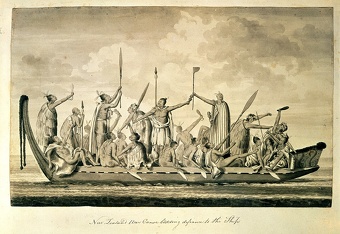
New Zealand war canoe bidding defiance to the ship; Described in Joseph Banks's journal, 29 March 1770
Of the Maori he wrote: “They eat their enemies slain in battle. This seems to come from customs not savage disposition... We introduce among them wants and...diseases which they never before knew...If anyone denies the truth of this assertion let him tell me what the Natives of America have gained by the commerce they have had with Europeans.
When Cook first arrived in New Zealand, Maori men seemed indifferent to the fact that some Maori women had sex with Cook’s sailors. On the second visit Maori men were forcing their women to have sex with the foreigners “Now we find the men are the chief promoters of Vice, and for a spike, nail or any other thing they value will oblige their wives and daughters to prostitute themselves whether they will or not.
Parkinson wrote: “Many of the women that we saw had very good features, and not the savage countenance one might expect; their lips were in general, stained of a blue colour, and several of them were scratched all over their faces as if it had been done with needles and pins.” [Source: Parkinson Journal, 98).
Cook described the tattoos of the older men of New Zealand: “Many of the old and some of the middle aged men have their faces mark’d or tattow’d with black and some few we have seen who have had their buttocks thighs and other parts of their bodies mark’d but this is less common. The figures they mostly use are spirals drawn and connected together with great nicety and judgement; they are so exact in the application of these figures that no difference can be found between the one side of the face and the other if the whole is mark’d, for some have only one side and some a little on both sides, hardly any but the old men have the whole tattowd. From this I conclude that it takes up some time perhaps years to finish the operation which all who have begun may not have perseverance enough to go through, as the manner in which it must be done must certainly cause intolerable pain…” [Source: Cook, Journals I, pp.278-9, March 1770]
Cook in Australia
Cook voyaged west from New Zealand reaching the southeastern coast of Australia near today's Point Hicks in April 1770, and in doing so his expedition became the first recorded Europeans to have encountered its eastern coastline. Cook arrived at the southeast extreme of Australia and sailed northward, making first landfall in a harbor (Botany Bay) near present-day Sydney.
Cook claimed the continent for King George III of England and named it New South Wales. Before he left, after rounding Cape York, he mapped 2000 miles of Australia's east coast.
Cook made his first recorded direct observation of Aboriginal Australians at Brush Island near Bawley Point, noting in his journal: "... and were so near the Shore as to distinguish several people upon the Sea beach they appear'd to be of a very dark or black Colour but whether this was the real colour of their skins or the Clothes they might have on I know not."
Cook’s First Voyage (1768–1771) in Australia
On Cook’s first voyage, Endeavour followed the east coastline of Australia northwards, keeping the land in sight with Cook charting and naming landmarks as he went. Cook and crew made their first landfall in Australia at a beach now known as Silver Beach on Botany Bay (Kamay Botany Bay National Park). Two Gweagal men of the Dharawal, Eora Aboriginal groups opposed their landing and in the confrontation one of them was shot and wounded. [Source: Wikipedia]
Cook and his crew stayed at Botany Bay for a week, collecting water, timber, fodder and botanical specimens and exploring the surrounding area. Cook sought to establish relations with the Indigenous population without success. At first Cook named the inlet "Sting-Ray Harbour" after the many stingrays found there. This was later changed to "Botanist Bay" and finally Botany Bay after the unique specimens retrieved by the botanists Joseph Banks and Daniel Solander. This first landing site was later to be promoted (particularly by Joseph Banks) as a suitable candidate for situating a settlement and British colonial outpost.
After his departure from Botany Bay, Cook continued northwards. He stopped at Bustard Bay (now known as Seventeen Seventy) on in May 1770. Cook and Banks and others went ashore. After being shipwrecked for a while (See Below) the voyage continued northward, reaching the northernmost tip of the east coast of Australia in August 1770 but didn’t disembark from the ship. Cook named the tip York Cape (now Cape York).
Leaving the east coast, Cook turned west and nursed his battered ship through the dangerously shallow waters of Torres Strait. Searching for a vantage point, Cook saw a steep hill on a nearby island from the top of which he hoped to see "a passage into the Indian Seas". Cook named the island Possession Island, where he claimed the entire coastline that he had just explored as British territory.
Cook Gets Shipwrecked in Australia
In June of 1770, the Endeavour ship ran aground on a reef near what is now Cookstown, Queensland, near the Great Barrier Reef at Whitsunday Island, , and then "nursed into a river mouth. The ship was badly damaged, and the voyage was delayed almost seven weeks while repairs were carried out on the beach (near the docks of modern Cooktown at the mouth of the Endeavour River). The crew's encounters with the local Aboriginal people were mostly peaceful, although following a dispute over green turtles Cook ordered shots to be fired and one local was lightly wounded.
The reef that damaged the ship was located inside the Great Barrier Reef in waters that had just been carefully sounded at a depth of 100 feet. The “Endeavour” ran aground so violently Banks wrote "we could hardly keep our legs upon the Quarter deck." Immediately after the ship wrecked Cook appeared on the deck "in his drawers" and ordered that 50 tons of ballast including the ship's valuable cannons be thrown overboard.
Crew members pumped water out of the hold and luckily when the ship finally drifted off the reef a large piece of coral lodged into the hole or else the ship might have sunk. Cook also ordered that the mainsail be wrapped under the bottom of the ship and fastened in place by rope and dung from the ship's livestock. The crippled ship drifted into the estuary of a river where a month was spent making repairs.≈ The six cannons that Cook dumped off the Great Barrier were salvaged in 1969 by Dr. Virgil Kauffman of the Academy of Natural Sciences of Philadelphia.
The “Endeavour” took a month to fix and the ship waited another month for favorable winds. The shipwrecked crew lived off tropical birds and turtles they hunted. Of the giant clams they saw, Bank wrote: "one of which was more than two men could eat. Many indeed were larger." Even though food was scarce Cook insisted that what food there was be divided equally among everyone. After shooting a strange animal that hopped around on its hind legs Cooks men asked an Aboriginal what it was. They were told it was a “gangurru”.
Cook and Aboriginals
Cook's expedition introduced the Aboriginals of Australia to the Western world for the first time. As it did the Maori of New Zealand and Banks wrote, "The natives of New Holland...may appear to be some of the most wretched people on earth. But in reality they are much happier than we Europeans, being wholly unacquainted with the superfluous...The Earth and the Sea of their own accord furnish them with all things necessary in life..."∝
The Aboriginals discovered by Cook were hunters with spears and fishermen with dugout canoes. They didn't practice circumcision or dentistry and they seldom went out at night out of fear of evil spirits that roamed the darkness. Cook wrote "they go quite naked both men and women without any Clothing whatever, even the women don't so much as cover their privities." After having gifts of beads spurned by the Aboriginals, Cook wrote in his journal, "All they seem to want was for us to be gone."
Cook wrote:“of a middles Stature straight bodied and slender-limbd, their skins the Colour of Wood soot or of a dark Chocolate, their hair mostly black…Their features are far from being disagreeable and their Voices are soft and tunable. They go quite naked both Men and women…they wear Oraments Necklaces made of shells, Bracelets or hoops about their arms, made mostly of hair…The men wear a bone about 3 or 4 Inches long and a fingers thick, run through the Bridge of the nose, which the Seamen Call’d a sprit sail yard…Many of them paint their bodies and faces with a sort of White paist or Pigmen” [Source: Cook Journals I, 395, August 1770]
On the weapons of the Aboriginals, Cook wrote: “Their Offensive weapons are Darts, some are only pointed at one end others are barb’d, some with wood others with the Stings of Rays and some with Sharks teeth…They throw the Dart with only one hand, in the doing of which they make use of a piece of wood about 3 feet long made thin like the blade of a Cutlass, with a little hook at one end to take hold of the end of the the Dart…by the help of these throwing sticks, as we call them, they will hit a Mark at the distance of 40 or 50 Yards, with almost, if not as much certainty as we can do with a Musquet…Their defensive weapons are Shields made of wood…” [Source: Cook Journals I, 395-6, August 1770]
Joseph Banks in Australia
With Cook was the famous botanist Joseph Bank, a blue-blooded nobleman who was accompanied by two footmen and two black servants from his estate as well two greyhounds and chemicals for storing specimens. Banks was not invited on the Cook's second voyage because his demands (including onboard musicians) were too much for the expedition to the meet.
Banks made many discoveries in Australia. Botany Bay was named Sting Ray Bay by Cook, who later renamed it after Banks enthusiasts botany efforts. "The great quality of New Plants...Mr. Banks and Dr. Solander collected in this place," Cook wrote, "occasioned my giving it the name of Botany Bay." Banks expanded the Western world' knowledge of plants by 25 percent. He described 10-foot-high Australian fern trees, banana and breadfruit trees, palm-like pandanus, hibiscus wild ginger, morning glory and some 30,000 kinds of plants and animals.
It was Bank's idea to colonize Australia with convicts. In 1779, Banks told the House of Commons that Botany Bay was the prefect place to set up a convict camp. In 1786, Lord Sydney announced that the king had selected Botany Bay as a place to send convicts under a policy called transportation. Before Australia was set as a penal colony, many convicts were shipped to the British colonies in America.
Botany Bay was named after the profusion of new plants found there. A new outlet was needed for convicts to be transported overseas in continuance of British penal policy after the loss of the 13 North American colonies. In 1786 the British government decided to adopt Bank’s recommendation. In 1787, 800 convicts on 11 ships sailed to Botany Bay. The ships carried sheep, cattle and seed, cuttings and living plants of peaches, pomegranates, limes, lemons, mustard, garlic, carrots, clover and dozens of other agricultural plants.
Cook’s Legacy in Australia
Cooktown, is the main town on Cape York in northeast Australia. The first institution of higher education in North Queensland, Australia, was named after him, with James Cook University opening in Townsville in 1970. In 1959, the Cooktown Re-enactment Association first performed a re-enactment of Cook's 1770 landing at the site of modern Cooktown, Australia, and have continued the tradition each year, with the support and participation of many of the local Guugu Yimithirr people.
The Australian Museum acquired its "Cook Collection" in 1894 from the Government of New South Wales. At that time the collection consisted of 115 artefacts collected on Cook's three voyages throughout the Pacific Ocean, during the period 1768–80, along with documents and memorabilia related to these voyages. Many of the ethnographic artefacts were collected at a time of first contact between Pacific Peoples and Europeans. The collection remained with the Colonial Secretary of NSW until 1894, when it was transferred to the Australian Museum.
The Australian slang phrase "Have a Captain Cook" means to have a look or conduct a brief inspection. In 1931, Kenneth Slessor's poem "Five Visions of Captain Cook" was the "most dramatic break-through" in Australian poetry of the 20th century according to poet Douglas Stewart. A larger-than-life statue of Cook upon a column stands in Hyde Park located in the centre of Sydney. A large aquatic monument is planned for Cook's landing place at Botany Bay, Sydney.
Cook appears as a symbolic and generic figure in several Aboriginal myths, often from regions where Cook did not encounter Aboriginal people. Maddock states that Cook is usually portrayed as the bringer of Western colonialism to Australia and is presented as a villain who brings immense social change.
Image Sources: Wikimedia Commons
Text Sources: Source: National Geographic article by Alan Villiers; the book "The Discoverers" by Daniel Boorstin, “Encyclopedia of World Cultures, Volume 2: Oceania,” edited by Terence E. Hays, 1991, Wikipedia, New York Times, Washington Post, Los Angeles Times, Times of London, Lonely Planet Guides, Library of Congress, The Guardian, National Geographic, Smithsonian magazine, The New Yorker, Reuters, Associated Press, AFP, BBC, CNN, and various books, websites and other publications.
Last updated October 2025

